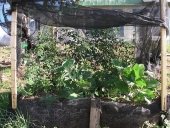
 5
5




 4
4




Blog: 5 Acres & A Dream
Books: Kikobian Books | Permies Digital Market
 1
1




 5
5




Moderator, Treatment Free Beekeepers group on Facebook.
https://www.facebook.com/groups/treatmentfreebeekeepers/





 1
1




Abraham Palma wrote:So your point is, more or less, that even if it is not the ideal, it's better than nothing.
Blog: 5 Acres & A Dream
Books: Kikobian Books | Permies Digital Market
 3
3




Earthworks are the skeleton; the plants and animals flesh out the design.
 1
1




Myron Platte wrote:My mind immediately goes to "schemes for water harvest". Does rain ever fall on your balcony? If so, where? Can you capture it creatively? You mentioned a nearly constant wind from the east. Does this lead to rain falling on the western side of the balcony more often? You might want to make a shaded rock pile to harvest humidity through condensation, which could than run down to the top of the pyramid bed. the less humidity you have, the less well it will work, though.
 2
2




Just my 2 cents...
Money may not make people happy but it will get you all the warm fuzzy puppies you can cuddle and that makes most people happy.
 1
1




Moderator, Treatment Free Beekeepers group on Facebook.
https://www.facebook.com/groups/treatmentfreebeekeepers/





 3
3




 2
2




Michael Cox wrote:I have been mulling this.
Permaculture is not just growing stuff. It’s about the whole cycle of plant to food to waste to plants...
Small land areas like balconies don’t lend themselves to growing meaningful amounts of food, so why not tackle other parts of the system.
Do you have an active composting or work bin for food waste? What about grey water?




Moderator, Treatment Free Beekeepers group on Facebook.
https://www.facebook.com/groups/treatmentfreebeekeepers/









Michael Cox wrote:I notice that you are located in Spain. I think black soldierfly are in your area, which are fantastic for fast composting in small places. Plus the larvae themselves can be a valuable product (used for feeding reptiles, birds, fish etc...)
 1
1




 2
2










Skandi Rogers wrote:Could you have the top layer as a worm bin? and then let the juices trickle down through the other layers? If weight is to much of an issue you could fill the very middle with an air space or some waste polystyrene or something to reduce the overall weight but not the surface area, it would of course reduce the volume as well.
 1
1








Blog: 5 Acres & A Dream
Books: Kikobian Books | Permies Digital Market
 1
1




 1
1




Our inability to change everything should not stop us from changing what we can.
 5
5




 5
5




 4
4








 2
2




 3
3




 1
1




Kena Landry wrote:I've had good results with rosemary, thyme and lavender in harsh balcony conditions.
Kena Landry wrote:Have you considered a potted citrus?
 5
5





|
His brain is the size of a cherry pit! About the size of this ad:
The new permaculture playing cards kickstarter is now live!
https://www.kickstarter.com/projects/paulwheaton/garden-cards
|





